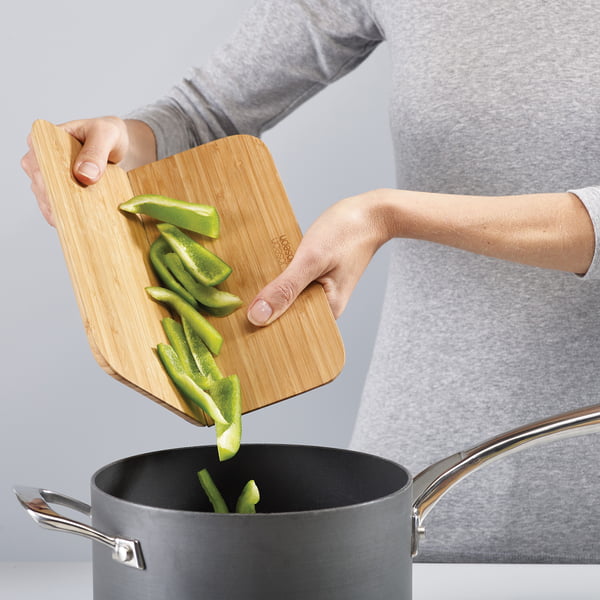Chopping boards - how to find the right one for your kitchen
- Kitchen board for every use: breakfast board, cutting board, serving board
- The material: wooden board, plastic board, marble top
- Additional features of kitchen boards
- The right hygiene: how do you clean cutting boards?
- Conclusion - this is what you have to consider when buying cutting boards
1. Boards for every use: breakfast board, cutting board, serving board
Each dish begins with the chopping of the individual ingredients. In addition to a sharp knife, the right chopping board (2) for chopping food is a great help.
A smaller breakfast board (1) is perfect for chopping fruit for the fruit muesli in the morning and can be used wonderfully as a snack board in the evening.
If ingredients are to be chopped or carved, a chopping board with extra height is advantageous. A carving board (4) has an above-average material thickness to protect the kitchen surfaces.
A cutting board made of wood, marble or stone can also be used as a stylish serving board (3) for cheese, fruit or snacks.
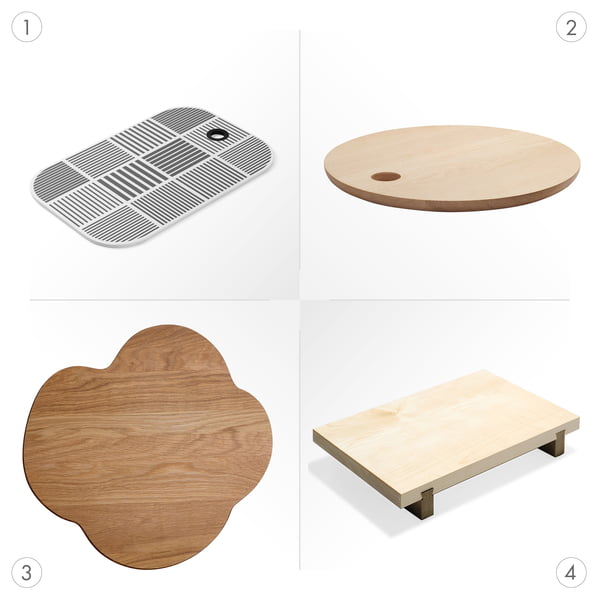
2. The material: wooden board, plastic board, marble top
Wooden boards (1) are among the most popular cutting boards due to their robust and natural characteristics. However, it should be noted that wood absorbs the smell of tasty food. We therefore recommend using a separate cutting board for ingredients such as garlic or onions. Wooden chopping boards are not dishwasher safe and should therefore be washed by hand.
Marble slabs and glass cutting boards (2) are particularly suitable for fruit and vegetables. Their smooth surface makes them resistant to food acids and does not absorb odours or tastes. Glass cutting boards can be easily cleaned in the dishwasher. Marble cutting boards should be cleaned by hand.
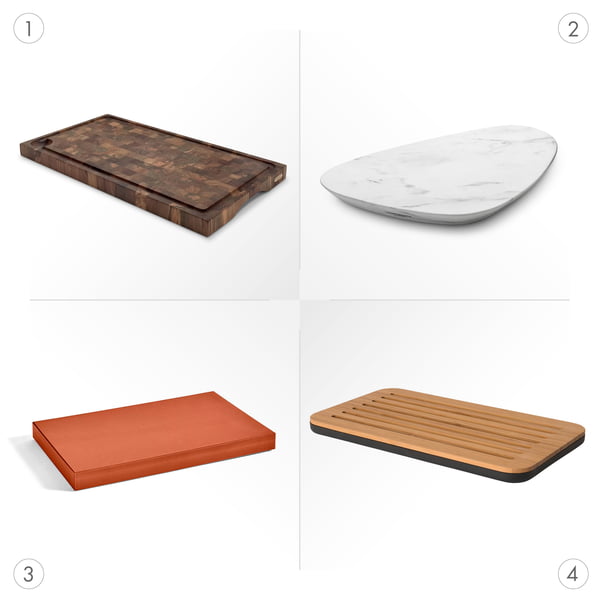
Plastic boards (3) impress with their lightness and flexibility. They are easy to clean and dishwasher safe, so that even ingredients with a strong smell can be prepared on them. The soft material composition of plastic boards also ensures that the blades of the knives do not dull as quickly.
Cutting boards made of different materials (4) not only provide a special eye-catcher when serving, but can also be turned over to process different ingredients separately. Thus, meat can be cut on one side and vegetables on the other side.
3. Additional features of kitchen boards
Cutting boards with additional functions make it easier to prepare food in a pleasant way. Folding plastic cutting boards (1), for example, guarantee that the ingredients always end up in the pan or cooking pot.
Cutting boards with juice grooves or collecting receptacles (2) are particularly practical when meat juice or vegetable juice accumulates during cutting. This keeps the cutting surface and kitchen surface clean at all times.
Cutting boards with integrated bowls or trays (3) are particularly suitable for serving. For example, vegetable sticks can be placed on the board while dipping from the bowl.
Board sets with colour coding (4) are advantageous when working with different foods in the kitchen. For example, one cutting board can be used for vegetables, one for fish, one for meat and one for odour-intensive food. Using different boards is also hygienic and reduces the spread of germs.
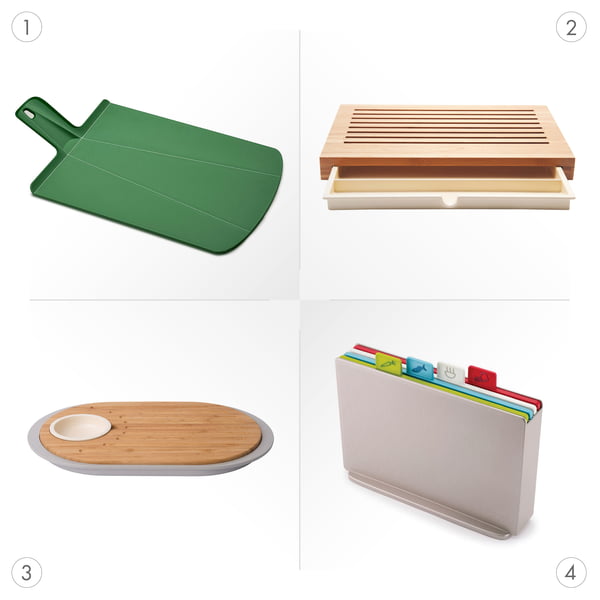
4. The right hygiene: How do you clean cutting boards?
While glass cutting boards and plastic boards can be cleaned in the dishwasher, it is recommended to wash marble slabs by hand. Wooden boards should under no circumstances be immersed under water, as the wood can otherwise become rotten. Since many woods (including bamboo, beech and acacia) have antibacterial properties, hand washing with a kitchen sponge is sufficient.
Especially when meat, fish and poultry are processed on the cutting board, thorough hygiene should be ensured. A water temperature of 60° C is sufficient to kill most bacteria.
Wooden boards should also be treated with linseed oil, olive oil, coconut oil or beeswax at regular intervals. Oiling ensures that knife cuts close up and germs cannot get inside your wooden board.
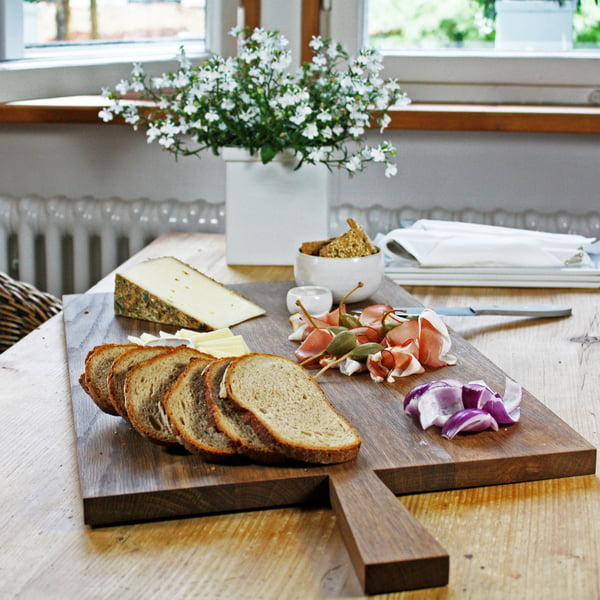
5. Conclusion
- Cutting boards can be used in many ways: for the classic preparation of ingredients, as a breakfast board for a snack, for carving poultry or for serving snacks.
- There is a wide variety of materials: wooden boards are the classic in the kitchen and particularly robust. Plastic boards, on the other hand, are extremely easy to clean and cutting boards made of marble or stone have a high-quality look - ideal for serving.
- The cooking process can be optimised with different features: Folding boards enable precise working, juice grooves catch liquids and boards with colour coding for different foods ensure hygiene in the kitchen.
- The cleaning of cutting boards depends on the material. Glass and plastic can be washed in a dishwasher, for wood and marble hand washing is recommended. For wooden boards, regular oiling is also worthwhile.
Buy cutting boards online at Connox - Your advantages at a glance
- high-quality cutting boards of the top design brands
- climate-neutral online shopping
- personal support by our customer service
- fair shipping costs
- secure payment thanks to SSL encryption
Purchasing consulting at Connox
You would like to buy a cutting board online, but need support? Please feel free to contact our customer service at any time. We will be happy to help you with your purchase, make recommendations and answer your questions quickly. Let us deliver your desired article directly to your home.
